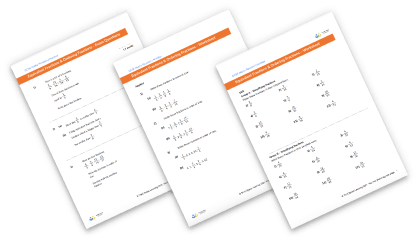GCSE Tutoring Programme
"Our chosen students improved 1.19 of a grade on average - 0.45 more than those who didn't have the tutoring."
This topic is relevant for:

Equivalent Fractions
Here we will learn about equivalent fractions including how to simplify fractions.
There are also equivalent fractions worksheets based on Edexcel, AQA and OCR exam questions, along with further guidance on where to go next if you’re still stuck.
What are equivalent fractions?
Equivalent fractions are fractions that have the same value.
We use equivalent fractions to write a fraction in its simplest terms. To do this we look at the numerator (the top number) and the denominator (the bottom number) and find a common factor to cancel.
The numerator and denominator are always whole numbers.
Equivalent fractions can be used to compare fractions when they have different denominators so that they can be written in order of size.
Here are some examples of the concept of equivalent fractions:
E.g.
E.g.
How to write equivalent fractions
In order to simplify fractions:
- Look at the numerator and the denominator and find the Highest Common Factor.
- Divide both the numerator and the denominator by the HCF.
- Write the fraction in its simplest terms.
In order to calculate equivalent fractions:
- Look at the denominators in both fractions and work out the multiplier.
- Multiply the numerator of one of the fractions by the multiplier.
- Complete the second fraction.

Equivalent fractions worksheet

Get your free equivalent fractions worksheet of 20+ questions and answers. Includes reasoning and applied questions.
DOWNLOAD FREE
Equivalent fractions worksheet

Get your free equivalent fractions worksheet of 20+ questions and answers. Includes reasoning and applied questions.
DOWNLOAD FREERelated lessons on fractions
Equivalent fractions is part of our series of lessons to support revision on fractions. You may find it helpful to start with the main fractions lesson for a summary of what to expect, or use the step by step guides below for further detail on individual topics. Other lessons in this series include:
Equivalent fractions examples
Example 1: simplify fractions
Write the following fraction in its simplest form:
- Look at the numerator and the denominator and find the Highest Common Factor.
The numerator of the fraction is
The denominator of the fraction is
They are both multiples of
2Divide both the numerator and the denominator by the HCF.
The HCF of
The new numerator is
3Write the fraction in its simplest terms.
Example 2: simplify fractions
Write the following fraction in its simplest form:
Look at the numerator and the denominator and find the Highest Common Factor.
The numerator for the fraction is
The denominator of the fraction is
They are both multiples of
Divide both the numerator and the denominator by the HCF.
The HCF of
The new numerator is
Write the fraction in its simplest terms.
Example 3: simplify fractions
Write the following fraction in its simplest form:
Look at the numerator and the denominator and find the Highest Common Factor.
The numerator for the fraction is
The denominator of the fraction is
They are both multiples of
The Highest Common Factor of
Divide both the numerator and the denominator by the HCF.
The HCF of
The new numerator is
Write the fraction in its simplest terms.
Example 4: calculating equivalent fractions
Find the missing value of these equivalent fractions:
Look at the denominators in both fractions and work out the multiplier.
The denominator of the first fraction is
The multiplier is
Multiply the numerator of one of the fractions by the multiplier.
The missing value is
Complete the second fraction.
Example 5: calculating equivalent fractions
Find the missing value of these equivalent fractions:
Look at the denominators in both fractions and work out the multiplier.
The denominator of the first fraction is
The multiplier is
Multiply the numerator of one of the fractions by the multiplier.
The missing value is
Complete the second fraction
Example 6: calculating equivalent fractions
Find the missing value of these equivalent fractions:
Look at the denominators in both fractions and work out the multiplier.
The denominator of the first fraction is
The multiplier is
Multiply the numerator of one of the fractions by the multiplier.
The missing value is
Complete the second fraction.
Common misconceptions
- Fractions in the simplest form
You can simplify a fraction by using any of the common factors of the numerator and the denominator of a fraction. However you may need to cancel more than once to make sure you have written the fraction in its simplest form.
Using the Highest Common Factor means that you will only have to cancel once
E.g.
Write the following fraction in its simplest form.
2
However the new fraction has not been written in its simplest form as the new numerator
The fraction in its simplest form is \frac{1}{3}
- Equivalent fractions and common factors
You cannot make equivalent fractions by using addition.
E.g.
This is incorrect cancelling.
This is correct cancelling.
- Fractions and equivalence
E.g.
Because \frac{5}{10} and \frac{1}{2} use different numbers (they have different numerators and denominators) they appear to be different fractions, however they are actually equivalent to each other.
Practice equivalent fractions questions
1. Write the following fraction in its simplest form: \frac{5}{20}




2. Write the following fraction in its simplest form: \frac{8}{24}
\frac{4}{12}

\frac{2}{6}

\frac{1}{3}

\frac{5}{12}

\frac{8}{24}=\frac{1\times8}{3\times8}=\frac{1}{3}
3. Write the following fraction in its simplest form: \frac{36}{48}
\frac{6}{8}

\frac{18}{24}

\frac{7}{12}

\frac{3}{4}

\frac{36}{48}=\frac{3\times12}{4\times12}=\frac{3}{4}
4. Find the missing value of these equivalent fractions: \frac{3}{4}=\frac{?}{24}
\frac{23}{24}

\frac{18}{24}

\frac{19}{24}

\frac{21}{24}

\frac{3}{4}=\frac{3\times6}{4\times6}=\frac{18}{24}
5. Find the missing value of these equivalent fractions: \frac{6}{7}=\frac{?}{28}
\frac{18}{28}

\frac{24}{28}

\frac{12}{28}

\frac{24}{28}

\frac{6}{7}=\frac{6\times4}{7\times4}=\frac{24}{28}
6. Find the missing value of these equivalent fractions: \frac{5}{9}=\frac{?}{63}
\frac{35}{63}

\frac{25}{63}

\frac{30}{63}

\frac{42}{63}

\frac{5}{9}=\frac{5\times7}{9\times7}=\frac{35}{63}
Equivalent fractions GCSE questions
1. Here is a list of four fractions.
\frac{15}{20} \frac{5}{25} \frac{3}{15} \frac{2}{10}
One of these fractions is not equivalent to \frac{1}{5}
Write down this fraction.
(1 mark)
\frac{15}{20}
(1)
2. Here is a list of four fractions.
\frac{18}{24} \frac{15}{20} \frac{28}{40} \frac{36}{48}
One of these fractions is not equivalent to \frac{3}{4}
Write down this fraction.
(1 mark)
\frac{28}{40}
(1)
3. (a) Show that \frac{3}{5} is bigger than \frac{5}{9} .
(b) Find a fraction which is bigger than \frac{3}{5}
but smaller than \frac{3}{4} .
(4 marks)
(a)
\frac{3\times9}{5\times9}=\frac{27}{45} \frac{5\times5}{9\times5}=\frac{25}{45}
for converting one fraction to an equivalent fraction
(1)
for both fractions with a common denominator
(1)
\frac{3}{5}=\frac{27}{45} \frac{5}{9}=\frac{25}{45}
(b)
\frac{3\times4}{5\times4}=\frac{12}{20} \frac{3\times5}{4\times5}=\frac{15}{20}
for converting one fraction to an equivalent fraction
(1)
for a correct answer between 0.6 and 0.75
(1)
\frac{13}{20} or \frac{14}{20} or \frac{7}{10}
Learning checklist
You have now learned how to:
- Simplify fractions
- Write an equivalent fraction for a given fraction
The next lessons are
Still stuck?
Prepare your KS4 students for maths GCSEs success with Third Space Learning. Weekly online one to one GCSE maths revision lessons delivered by expert maths tutors.

Find out more about our GCSE maths tuition programme.